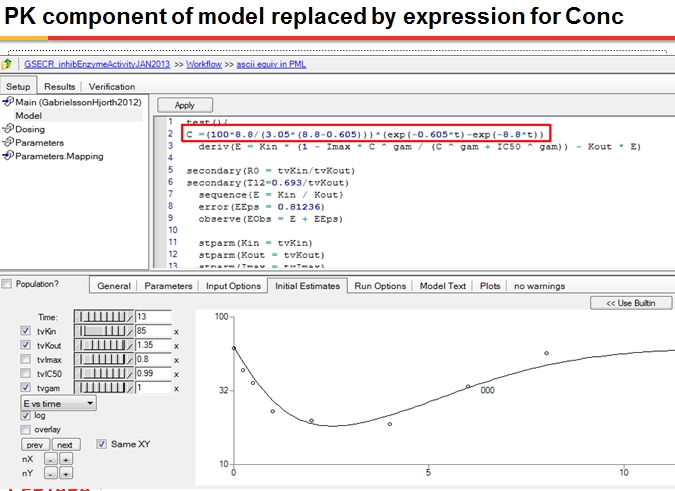I was wondering if someone can show me how to replace the Kin using the basline kinetic in the following equation. dR/dt=Kin I-KoutR my current codes are : deriv(E = Kin*(1 - Imax * C / (C + IC50)) - Kout) * E) Kin=R0+slope*t R0=40 sequence{E = R0} error(EEps = 0.5) observe(EObs = E + EEps) stparm(Imax = tvImax * exp(nImax)) stparm(IC50 = tvIC50 * exp(nIC50)) stparm(Kout = tvKout * exp(nKout)) fixef(tvImax = c(, 0.6, )) fixef(tvIC50 = c(, 100, )) fixef(tvKout = c(, 0.003, )) fixef(slope= c(, 0.17, )) ranef(diag(nslope nKout, nImax, nIC50, ) = c(1, 1, 1, 1 )) Many thanks in advance, Bo
Bo, What do you mean replace Kin with a baseline kinetic? I don’t seem to understand what you are asking. Nathan
Dear BO You must firsr take care of the units in your model deriv(E = Kin*(1 - Imax * C / (C + IC50)) - Kout) * E) is not correct and should be deriv(E = Kin*(1 - Imax * C / (C + IC50)) - Kout * E) Kin=R0+slopet R0=40 sequence{E = R0} Kin must have the units of response per unit of time. However you write Kin=R0+slopet and here Kin has units of response. There is therefore a mismatch and this model cannot be right. Please explain the basis of your model and what you are trying to do and me or somebody else will be bale to help you. The question you ask is not clear. best Serge
Thank you, Serge and Nathan I am trying to do a PK/PD modeling for an obesity drug. The body weight loss is the PD readout. In the animal models (mouse/ rat ), the body weight of vehicle control group increased gradually during the 4-weeks studies. In order to fit all the data ( different dose groups + vehicle control group), I thought I need to consider the baseline kinetic (the BW change of vehicle control group). Someone told me to replace the Kin in the indirect response model I (R= KinI+Kout R) using Kin= R0+ Slope (t). From the vehicle control group, I can determine the slope and R0. Serge, you are right the unit of (R0+Slope(t)) is not match the Kin unit ( per time ) Any suggestions? Thanks, Bo
modeling a time varying baseline is tricky. a good poster to start is at : http://www.cognigencorp.com/images/uploads/posters/poster84_Taranabant_PKPD_ACOP_2009_final.pdf Also have a look at the fDA weight loss model: http://www.fda.gov/ohrms/dockets/ac/06/briefing/2006-4248B1-04-FDA-topic-3-replacement.pdf Think always about your disease ( PD) model as something like this: Disease progression = function of time ( placebo) + drug (effect) you are on the right path we typically start by modeling the placebo (vehicle) to have a good understanding on how things ebolve without a drug. An indirect response model might not be the best for this type of model ! Samer
Dear BO and Samer I would propose a very simple model but that works often. The idea is that the time dependence can be handled through the baseline weight itself. You assume a non steady state situation at time=0 and the average population has the same model parameters. Look at the project I made and you will see that weight increase follow this kind of trend (my experience with this kind of data). Then you see that weight increase up to a maximum and the trend depends on the initial weight itself read as a covariate. The same applies for the drug effect. Do you have data we can use to test this simple model. I would prefer not having directly the time in your model because then when you simulate like multiple doses, how are you going to handle the time? Let me know what you think. Best Serge test(){ deriv(E = Kin * (1 - Imax * C / (C + IC50)) - Kout * E) cfMicro(A1, Cl / V, first = (Aa = Ka)) dosepoint(Aa) covariate(dosing) C = A1 / V sequence{E = baseline} error(CEps = 0.1) observe(CObs = C * (1 + CEps)) error(EEps = 0.1) observe(EObs = E * (1 + EEps)) stparm(V = tvV * exp(nV)) stparm(Cl = tvCl * exp(nCl)) stparm(Kin = tvKin * exp(nKin)) stparm(Kout = tvKout * exp(nKout)) stparm(Imax = tvImax * exp(nImax)) stparm(IC50 = tvIC50 * exp(nIC50)) covariate(baseline) fixef(tvV = c(, 1, )) fixef(tvCl = c(, 1, )) fixef(tvKin = c(, 100, )) fixef(tvKout = c(, 1, )) fixef(tvImax = c(, 0.5, )) fixef(tvIC50 = c(, 10, )) fixef(tvKa = c(, 1, )) ranef(diag(nV, nCl, nKin, nKout, nImax, nIC50) = c(0.00000001,0.000000001,0.000000001,0.0000001,0.00000001,0.00000001)) ranef(diag( nKa) = c(0.000000001)) stparm(Ka = tvKa * exp(nKa)) } [file name=obesity_example.phxproj size=750463]Certara | Drug Development Solutions (733 KB)

